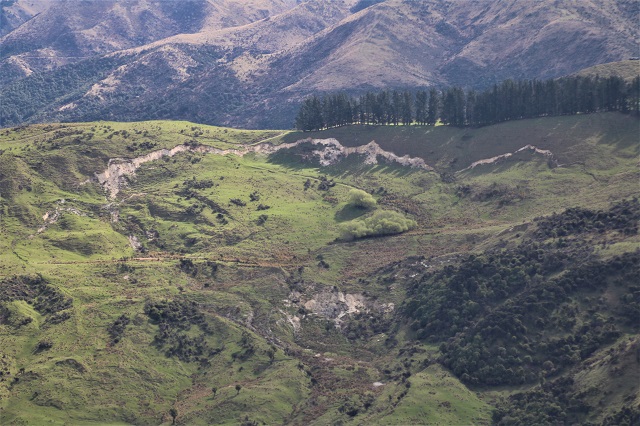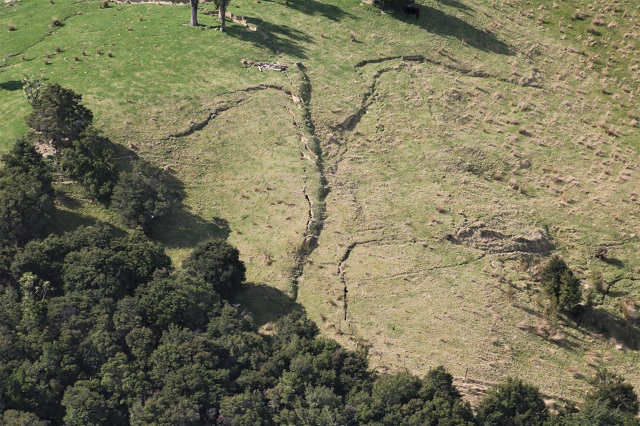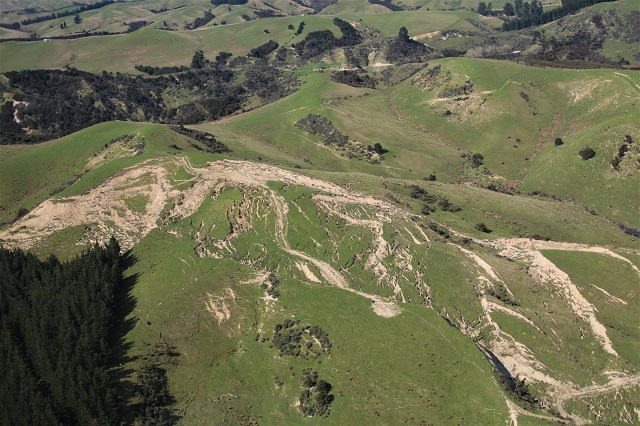18 September 2017
Landslides from the Kaikoura Earthquake Part 4: partially failed slopes
Posted by Dave Petley
Landslides from the Kaikoura Earthquake Part 4: partially failed slopes
A characteristic of every large landslide-inducing large earthquake that I have studied is the large number of partially failed slopes. These are slopes that have started to fail during the earthquake, but have not completely collapsed. Typically, in an earthquake-affected mountain chain we see numerous examples of this phenomenon. The Kaikoura Earthquake was no exception. I present here a number of examples. Sometimes these partially failed slopes are very obvious incipient landslides – this one for example is very clear:-

An example of a partially failed slope from the Kaikoura earthquake.
.
In other cases the features are much more subtle. This is an example of a highly deformed slope that has the complex morphology of several arcuate tension cracks and lateral scarps, but it is clear that the amount of strain (movement) is quite limited to date:-

The complex arcuate scarps of a partially failed slope from the Kaikoura earthquake.
.
In other cases the slope processes leave an incredibly complex pattern of extension and deformation, to the extent that it takes a while to work out what is happening in the landscape:-

A very complex partially failed slope generated by the Kaikoura earthquake.
.
And sometimes we are left with multiple arrays of parallel tension cracks. This was a very common pattern in 2005 Kashmir Earthquake in Pakistan. We saw the same pattern, but to a lesser degree, in the Kaikoura Earthquake in some locations:-

A partially failed slope from the Kaikoura earthquake.
.
Anticipating how these slopes may behave is very challenging at the scale of any individual slope and across the whole landscape. Clearly the nature of the long term hazard will be very dependent on this effect. Interestingly, in many other earthquakes the majority of such partially failed slopes have not failed (although in every case some slopes have collapsed, which preclused making assumptions about future behaviour). The exception may be the 2008 Wenchuan Earthquake, where these secondary failures remain a very major problem nine years on.
It will be fascinating to observe what happens in the aftermath of this event.
.
Landslides from the Kaikoura Earthquake
The earlier posts in this series are as follows:
- Landslides from the Kaikoura earthquake part 1: the Seafront landslide
- Landslides from the Kaikoura Earthquake part 2: the Hapuku landslide
- Landslides from the Kaikoura Earthquake part 3: the Leader 220 landslide


 Dave Petley is the Vice-Chancellor of the University of Hull in the United Kingdom. His blog provides commentary and analysis of landslide events occurring worldwide, including the landslides themselves, latest research, and conferences and meetings.
Dave Petley is the Vice-Chancellor of the University of Hull in the United Kingdom. His blog provides commentary and analysis of landslide events occurring worldwide, including the landslides themselves, latest research, and conferences and meetings.